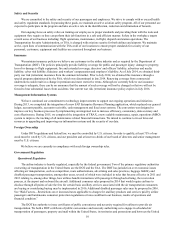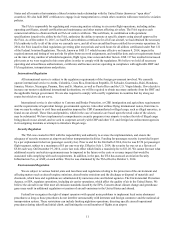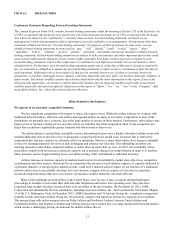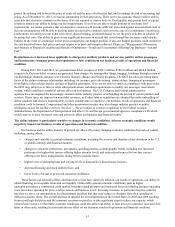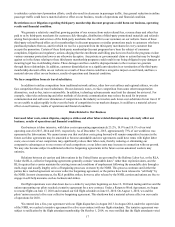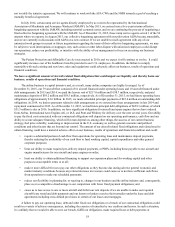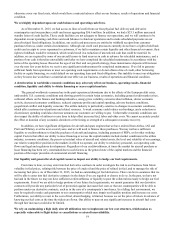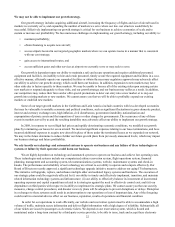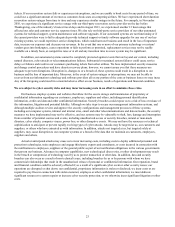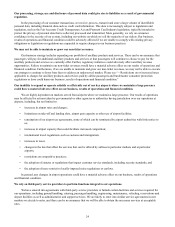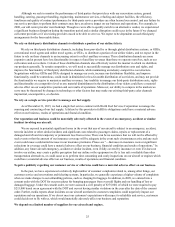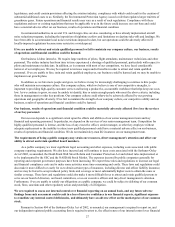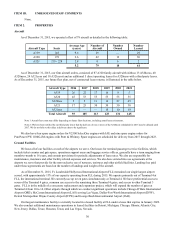Spirit Airlines 2015 Annual Report Download - page 20
Download and view the complete annual report
Please find page 20 of the 2015 Spirit Airlines annual report below. You can navigate through the pages in the report by either clicking on the pages listed below, or by using the keyword search tool below to find specific information within the annual report.20
We maintain a high daily aircraft utilization rate. Our average daily aircraft utilization was 12.7 hours for 2015, 2014 and
2013. Aircraft utilization is the average amount of time per day that our aircraft spend carrying passengers. Our revenue per
aircraft can be increased by high daily aircraft utilization, which is achieved in part by reducing turnaround times at airports so
we can fly more hours on average in a day. Aircraft utilization is reduced by delays and cancellations from various factors,
many of which are beyond our control, including air traffic congestion at airports or other air traffic control problems, adverse
weather conditions, increased security measures or breaches in security, international or domestic conflicts, terrorist activity, or
other changes in business conditions. A significant portion of our operations are concentrated in markets such as South Florida,
the Caribbean, Latin America and the Northeast and northern Midwest regions of the United States, which are particularly
vulnerable to weather, airport traffic constraints and other delays. In addition, pulling aircraft out of service for unscheduled
and scheduled maintenance, the occurrence of which will increase as our fleet ages, may materially reduce our average fleet
utilization and require that we seek short-term substitute capacity at increased costs. Due to the relatively small size of our fleet
and high daily aircraft utilization rate, the unavailability of one or more aircraft and resulting reduced capacity could have a
material adverse effect on our business, results of operations and financial condition.
Our maintenance costs will increase as our fleet ages, and we will periodically incur substantial maintenance costs due
to the maintenance schedules of our aircraft fleet.
As of December 31, 2015, the average age of our aircraft was approximately 5.2 years. Our relatively new aircraft require
less maintenance now than they will in the future. Our fleet will require more maintenance as it ages and our maintenance and
repair expenses for each of our aircraft will be incurred at approximately the same intervals. For our leased aircraft, we expect
that the final heavy maintenance events will be amortized over the remaining lease term rather than until the next estimated
heavy maintenance event, because we account for heavy maintenance under the deferral method. This will result in
significantly higher depreciation and amortization expense related to heavy maintenance in the last few years of the leases as
compared to the costs in earlier periods. Moreover, because our current fleet was acquired over a relatively short period,
significant maintenance that is scheduled on each of these planes is occurring at roughly the same time, meaning we will incur
our most expensive scheduled maintenance obligations, known as heavy maintenance, across our present fleet around the same
time. These more significant maintenance activities result in out-of-service periods during which our aircraft are dedicated to
maintenance activities and unavailable to fly revenue service. In addition, the terms of some of our lease agreements require us
to pay maintenance reserves to the lessor in advance of the performance of major maintenance, resulting in our recording
significant prepaid deposits on our balance sheet. Depending on their recoverability, these maintenance reserves may be
classified as supplemental rent. We expect scheduled and unscheduled aircraft maintenance expenses to increase as a
percentage of our revenue over the next several years. Any significant increase in maintenance and repair expenses would have
a material adverse effect on our business, results of operations and financial condition. Please see “Management’s Discussion
and Analysis of Financial Condition and Results of Operations—Critical Accounting Policies and Estimates—Aircraft
Maintenance, Materials and Repair Costs and Heavy Maintenance Amortization” and “—Maintenance Reserves.”
Our lack of marketing alliances could harm our business.
Many airlines, including the domestic traditional network airlines (American, Delta and United) have marketing alliances
with other airlines, under which they market and advertise their status as marketing alliance partners. These alliances, such as
OneWorld, SkyTeam and Star Alliance, generally provide for code-sharing, frequent flier program reciprocity, coordinated
scheduling of flights to permit convenient connections and other joint marketing activities. Such arrangements permit an airline
to market flights operated by other alliance members as its own. This increases the destinations, connections and frequencies
offered by the airline and provides an opportunity to increase traffic on that airline’s segment of flights connecting with alliance
partners. We currently do not have any alliances with U.S. or foreign airlines. Our lack of marketing alliances puts us at a
competitive disadvantage to traditional network carriers who are able to attract passengers through more widespread alliances,
particularly on international routes, and that disadvantage may result in a material adverse effect on our passenger traffic,
business, results of operations and financial condition.
We are subject to extensive and increasing regulation by the FAA, DOT, TSA and other U.S. and foreign governmental
agencies, compliance with which could cause us to incur increased costs and adversely affect our business and financial
results.
Airlines are subject to extensive and increasing regulatory and legal compliance requirements, both domestically and
internationally, that involve significant costs. In the last several years, Congress has passed laws, and the DOT, FAA and TSA
have issued regulations, relating to the operation of airlines that have required significant expenditures. We expect to continue
to incur expenses in connection with complying with government regulations. Additional laws, regulations, taxes and increased
airport rates and charges have been proposed from time to time that could significantly increase the cost of airline operations or
reduce the demand for air travel. If adopted, these measures could have the effect of raising ticket prices, reducing revenue and
increasing costs. For example, the DOT finalized rules in April 2010 requiring new procedures for customer handling during


